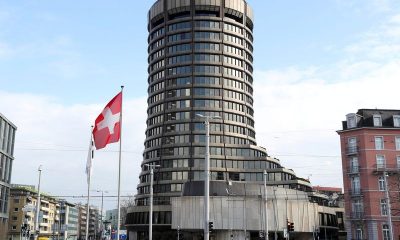Forex
Dollar edges down, ether’s 2-month high fuels crypto rally

By Stefano Rebaudo
(Reuters) -The dollar struggled for direction on Tuesday as investors stuck to their views for the expected timing of Federal Reserve monetary easing this year.
Ether was set for its largest two-day gain in nearly two years and bitcoin approached a record high on speculation about the outcome of applications for U.S. spot exchange-traded funds that would track the world’s second-biggest cryptocurrency.
The euro rose 0.12% to $1.0869.
Investors are awaiting Thursday’s data from the European Central Bank (ECB) negotiated wage tracker and the euro zone Purchasing Managers’ Index (PMI) which could provide further clues about the monetary cycle in the euro area.
Meanwhile, with little on the U.S. economic data calendar this week to guide the direction of the dollar, investors’ focus is turning to a slew of Federal Reserve speakers.
Several officials on Monday called for continued policy caution, even after data last week showed an easing in consumer price pressures in April.
Money markets are now pricing in 42 basis points (bps) of Fed rate cuts in 2024 — implying one 25 bps reduction and a 68% chance of a second move by December — from fully pricing in two cuts before recent hawkish comments from central bank officials.
They are betting on 63 bps of ECB rate cuts in 2024 from around 73 bps in mid-May.
Some analysts highlighted that Atlanta Fed President Raphael Bostic made dollar-positive remarks when he cautioned that the Fed’s benchmark rate would likely end up at a higher steady rate than in the past decade.
“We expect the dollar to weaken after the first rate cut (by the Fed), which markets now price in September, but we also see the risk of a delay in the monetary easing with the Fed making the first move in December,” said Athanasios Vamvakidis, global head of forex strategy at BofA.
Against a basket of currencies, the dollar dropped 0.08% at 104.52.
“We see risks towards far greater divergence favouring the Fed,” argued George Saravelos, global head of forex research at Deutsche Bank, after noting remarkable symmetry in monetary policy that is still priced in by markets.
“Combined with the status of high-yielding currency, this provides a powerful underpinning to USD strength,” he added.
On the data front, the focus will now be on the Personal Consumption Expenditures (PCE) price index report – the Fed’s preferred gauge of inflation – due on May 31.
In the cryptoverse, ether jumped 6.2% to $3.715.60 after hitting $3,730.70, its highest level since March 16. It surged nearly 14% in the previous session – its largest daily percentage gain since November 2022.
broke above the $70,000 level and was last trading 2% higher at $71,128. It hit its all-time high at $73,803.25 in March.
The jump in cryptocurrencies also has “to do with that core (U.S.) inflation data last week that’s boosted risk sentiment and obviously brought rate cuts back into play,” said Tony Sycamore, a market analyst at IG.
Against the yen, the dollar dropped 0.06% to 156.20, not far from its lowest in over 30 years at around 160.
Fears of intervention from Japanese authorities deterred traders from pushing the yen to new lows. However, the still-stark interest rate differentials between the U.S. and Japan maintained the appeal of the yen as a funding currency.
“Forex interventions can buy some time and temporarily avoid an excessive depreciation of the yen, but if the Fed starts cutting later than the markets currently expect, it can become challenging for Japanese authorities to keep the yen below certain levels,” BofA’s Vamvakidis argued.
The Canadian dollar was flat at $1.3627 ahead of inflation data later in the session.
“We have called for a Bank of Canada (BoC) rate cut in June for the past couple of months, and are expecting that to make the increasingly less attractive compared to other commodity currencies,” said Francesco Pesole strategist at ING.

The BoC would be willing to cut interest rates three times ahead of the Fed first move, according to a Reuters poll.
The New Zealand dollar fell 0.03% to $0.6103, before the Reserve Bank of New Zealand policy meeting which is expected to hold its key interest rate at 5.50% on Wednesday.

 Forex3 years ago
Forex3 years agoForex Today: the dollar is gaining strength amid gloomy sentiment at the start of the Fed’s week

 Forex3 years ago
Forex3 years agoUnbiased review of Pocket Option broker

 Forex3 years ago
Forex3 years agoDollar to pound sterling exchange rate today: Pound plummeted to its lowest since 1985

 Forex3 years ago
Forex3 years agoHow is the Australian dollar doing today?

 Cryptocurrency3 years ago
Cryptocurrency3 years agoWhat happened in the crypto market – current events today

 World3 years ago
World3 years agoWhy are modern video games an art form?

 Commodities3 years ago
Commodities3 years agoCopper continues to fall in price on expectations of lower demand in China

 Economy3 years ago
Economy3 years agoCrude oil tankers double in price due to EU anti-Russian sanctions


































